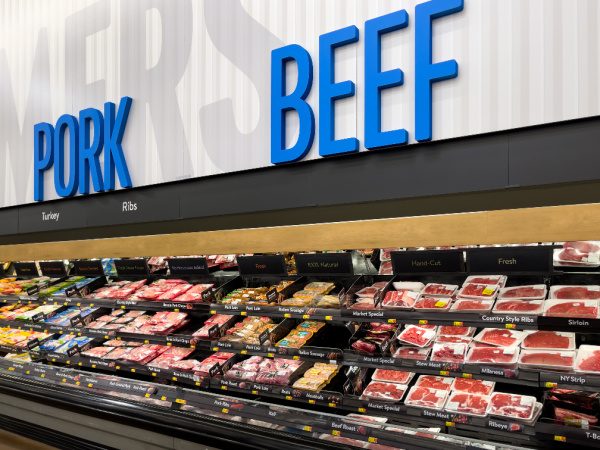Beef Consumption Continues Higher, Trouble Ahead?

Supply chains, prices, and consumer preferences have been erratic in recent memory. Most often, we hear about soaring prices (and occasionally, price plunges), but consumption trends, especially over several years, are frequently overlooked. This week, we review recent meat consumption trends and what 2023 and 2024 may have in store.
Beef Consumption Trends
For beef, the long-run story has been a decades-long decline in per capita consumption (Figure 1). In the 1970s, domestic consumption ranged from 80 to 95 pounds per capita. To be more precise, the annual average for the decade was 86 pounds. Fast forwarding to today, consumption for the most recent decade (2013-2022) averaged just 57 pounds and dipped to an annual low of 54 pounds in 2015.
Despite all of the recent shocks, beef consumption has trended higher in recent years. In 2022, consumption is estimated at 59.1 pounds, the highest since 2010.
We’ve written previously about changes in gasoline consumption around and after the Great Recession, and the situation for beef has been similar. From 2000-2019, beef consumption averaged 65.4 pounds per capita, 8.6 pounds (15%) higher than what was observed in the most recent decade (2013-2022).

Figure 1. U.S. Beef Consumption, 1970-2022. Data Source, USDA ERS.
Poultry and Pork Consumption Trends
Figure 2 plots the steady increase in poultry consumption over the last six decades. During the 1970s, U.S. consumption averaged 50.6 pounds per capita. In 2022, consumption hit a record 111.6 pounds. Despite the upward consumption trend, poultry wasn’t immune to the Great Recession dip.

Figure 2. U.S. Total Poultry Consumption, 1970-2022. Data Source: USDA ERS.
With a steady consumption trend, the U.S. has consumed around 50 pounds of pork annually since the 1970s. There have been ups (the early 1970s) and downs (the mid-1970s and 2010-2014), but the overall trend is flat and fairly stable.

Figure 3. U.S. Pork Consumption, 1970-2022. Data Source: USDA ERS.
Trouble For Beef Ahead?
While most of us skim the monthly WASDE reports for grain production and usage estimate, the report includes estimates of meat consumption. Figure 4 plots beef consumption from 2010-2022 along with the WASDE estimate for 2023 and 2024 (in red). In May, U.S. beef consumption for 2023 was forecasted to slip to 57.0 pounds. For 2024, a bigger decline – down to 52.8 pounds – is expected. If these early 2024 estimates are realized, it would be the lowest beef consumption observed since 1970, behind the 2015 low of 54.0.
I was curious about what the USDA previously estimated for 2022 and 2023. Last May, they forecasted 59.0 pounds for 2022 (currently estimated at 59.1) and 55.1 pounds (currently forecasted at 57.0) for 2023. Clearly, a lot of factors have to be considered when forecasting consumption that far in advance – including but not limited to weather and macroeconomic conditions – but it’s worth keeping these estimates in mind.

Figure 4. U.S. Beef Consumption, 1970-2024F. Data Source: USDA ERS and WASDE.
Wrapping It Up
Thinking back to spring 2020, many of us would be surprised to learn beef and poultry consumption continued to increase through 2022. Despite all the challenges, including the brief recession, a decrease in beef and poultry consumption wasn’t observed in the annual 2020 data. Furthermore, the subsequent supply chain and price issues didn’t curtail the expansions in 2021 and 2022.
It’s worth mentioning that these data are simply consumption. Consumption data alone don’t report on the overall status of demand. As a reminder, demand is the relationship between prices paid and the quantities consumed.